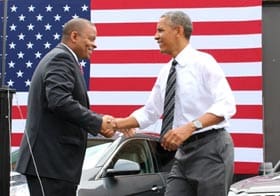 President Obama got into the driver’s seat at the Turner-Fairbank Highway Research Center in McLean, VA to try out vehicle driving simulation.
President Obama got into the driver’s seat at the Turner-Fairbank Highway Research Center in McLean, VA to try out vehicle driving simulation.
“Man, this is so exciting,” he remarked. “I haven’t been on the road in a long time.” After his test drive he said, “It was sort of like ‘Knight Rider.”
The president after a tour of the facility stated that self-driving cars could cut reduce accidents, gas use and commuting times. He noted that 80% of crashes could be abated and 3,9 million gallons of gas.
He also thought it was great that as a father of teenager, making driving safer is important to him as well as being good for the economy.
Obama wants Congress to fund more programs of the Federal Highway Trust fund. He also reported that traffic costs the average driver $800 a year in gas and outdated roads cause businesses to pay $27 billion more in freight costs.
He like that the technology of V2V and V2I helps saves lives, saves money and leads to new jobs in new industries.
He said, “Instead of barely paying our bills in the present, we should be investing in the future.”
He did complain that the driving simulator did not have radio.
The President visited the Human Factors Laboratory and Saxton Transportation Operations Laboratory, and spoke to employees .
 NXP Semiconductors announced its secure connected car V2X RoadLINK chips will be available for the first time from Delphi RoadLink for Vehicle-to-Vehicle (V2V) and Vehicle-to-Infrastructure (V2I) communication using autograde Wi-Fi (IEEE 802.11p). This would enable connected cars to have V2V and V2I features in use on roads in two years.
NXP Semiconductors announced its secure connected car V2X RoadLINK chips will be available for the first time from Delphi RoadLink for Vehicle-to-Vehicle (V2V) and Vehicle-to-Infrastructure (V2I) communication using autograde Wi-Fi (IEEE 802.11p). This would enable connected cars to have V2V and V2I features in use on roads in two years.








